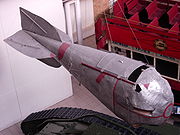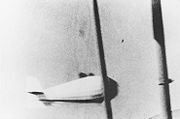
Spy basket
Encyclopedia


World War I
World War I , which was predominantly called the World War or the Great War from its occurrence until 1939, and the First World War or World War I thereafter, was a major war centred in Europe that began on 28 July 1914 and lasted until 11 November 1918...
on their military airship
Airship
An airship or dirigible is a type of aerostat or "lighter-than-air aircraft" that can be steered and propelled through the air using rudders and propellers or other thrust mechanisms...
s. The spy basket could be lowered from above through the cloud deck several hundred metres, in order to inconspicuously observe the ground and to help navigate the airship.
Development
The Peilgondel was developed by Paul JarayPaul Jaray
Paul Jaray , 11 March 1889 Vienna–22 September 1974 St. Gallen, was an engineer and a pioneer of automotive streamlining.-Life:Jaray, of Hungarian-Jewish descent, was born in Vienna...
to act as a heavy plumbbob for an airship's radio antenna. A free-hanging antenna wire would move and flex in the wind hindering communications; the added weight reduced this movement. Juray then developed the Peilgondel further into a manned spy gondola.
Use
Spy baskets were used on, among others, Schütte-LanzSchütte-Lanz
Schütte-Lanz is the name of a series of rigid airships designed and built by the Luftschiffbau Schütte-Lanz company from 1909 until the last LS22 was delivered in 1917. One research and four passenger airships were planned for post-war use, but were never built...
and Zeppelin
Zeppelin
A Zeppelin is a type of rigid airship pioneered by the German Count Ferdinand von Zeppelin in the early 20th century. It was based on designs he had outlined in 1874 and detailed in 1893. His plans were reviewed by committee in 1894 and patented in the United States on 14 March 1899...
airships. , it was not always certain which airships used them: the blueprints for LZ 62 (L 30) and LZ 72 (L 31) included the spy basket operating plant but the German Navy was no longer installing them at that time; however a fish-shaped spy basket can be seen on photographs of the German Army LZ 83 (tactical number LZ 113). The Imperial War Museum exhibits a Zeppelin observation car that was found near Colchester after the Zeppelin air raid of September 2nd, 1916 which is believed to have fallen from the LZ 90. After the war the Americans experimented with spy baskets on the USS Akron and USS Macon
USS Macon (ZRS-5)
USS Macon was a rigid airship built and operated by the United States Navy for scouting. She served as a "flying aircraft carrier", launching Curtiss F9C Sparrowhawk biplane fighters. In service for less than two years, in 1935 Macon was damaged in a storm and lost off California's Big Sur coast,...
.
Zeppelin spy basket development and use
Captain Ernst A. LehmannErnst A. Lehmann
Captain Ernst August Lehmann was a German Zeppelin captain. He was one of the most famous and experienced figures in German airship travel.- Pre-war experience :...
, the German airship captain, described in his book The Zeppelins how he and Baron Gemmingen, Count Zeppelin
Ferdinand von Zeppelin
Ferdinand Adolf Heinrich August Graf von Zeppelin was a German general and later aircraft manufacturer. He founded the Zeppelin Airship company...
's nephew, had developed the device. To test the prototype he blindfolded the helmsman of the airship and allowed himself to be lowered by a winch from the bombroom in a modified cask, equipped with a telephone. Hanging some 500 feet (152.4 m) below the airship using a compass he could tell the helmsman which bearing to take and effectively drive the airship. He later recounted how, while returning from the aborted raid on London in March 1916 in the Z 12, Baron Gemmingen insisted on being the first to use it on their secondary target, Calais. The basket was equipped with a wicker chair, chart table, electric lamp, compass, telephone, and lightning conductor. With the Zeppelin sometimes within, sometimes above the clouds and unable to see the ground, Gemmingen in the hanging basket would relay orders on navigation and when and which bombs to drop. The Calais defenders could hear the engines but their searchlights and artillery fire did not reach the airship.
LZ26's basket was lowered from the airship on a specially constructed tether 1000 metres long; other airships may have used one approximately 750 metres long. The tether was high grade steel with a brass core insulated with rubber to act as the telephone cable.
Despite Gemmingen reporting a feeling of loneliness while being lowered and losing sight of the airship, crewmen would nevertheless volunteer for this duty because it was the one place they could smoke.
External links
- German Wikipedia. photograph of the manned Juray fish-shaped spy gondola

